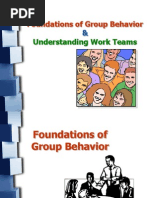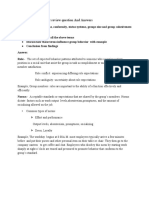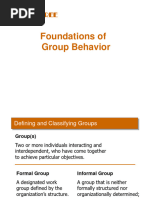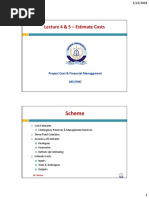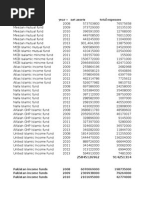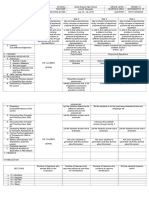Foundations of Group Behavior
Foundations of Group Behavior
Uploaded by
Fazal WahabCopyright:
Available Formats
Foundations of Group Behavior
Foundations of Group Behavior
Uploaded by
Fazal WahabOriginal Description:
Original Title
Copyright
Available Formats
Share this document
Did you find this document useful?
Is this content inappropriate?
Copyright:
Available Formats
Foundations of Group Behavior
Foundations of Group Behavior
Uploaded by
Fazal WahabCopyright:
Available Formats
0
Foundations of
Group Behavior
Chapter NINE
1
Group(s)
Two or more individuals interacting and
interdependent, who have come together
to achieve particular objectives.
Formal Group
A designated work
group defined by the
organizations structure.
Informal Group
A group that is neither
formally structured nor
organizationally determined;
appears in response to the
need for social contact.
Proximity, interactions, & emotion.
Defining and Classifying Groups
2
Command Group
A group composed of
the individuals who
report directly to a
given manager.
Task Group
Those working together
to complete a job or task.
Interest Group
Those working together
to attain a specific
objective with which
each is concerned.
Friendship Group
Those brought together
because they share one
or more common
characteristics.
Defining and Classifying Groups
3
Why People Join Groups
Security
Status
Self-esteem
Affiliation
Power
Goal Achievement
4
The Five-Stage Model of Group Development
Forming Stage
The first stage in group development, characterized
by much uncertainty.
Storming Stage
The second stage in group development,
characterized by intragroup conflict.
Norming Stage
The third stage in group
development, characterized
by close relationships and
cohesiveness.
5
Group Development
Performing Stage
The fourth stage in group development, when the
group is fully functional.
Adjourning Stage
The final stage in group
development for temporary
groups, characterized by
concern with wrapping up
activities rather than
performance.
Stages of Group Development
E X H I B I T 92
7
An Alternative Model: Temporary Groups
with Deadlines
Sequence of actions:
1. Setting group direction
2. First phase of inertia
3. Half-way point transition
4. Major changes
5. Second phase of inertia
6. Accelerated activity
Punctuated-Equilibrium
Model
Temporary groups
under time constrained
deadlines go through
transitions between
inertia and activity---at
the half-way point,
they experience an
increase in productivity.
8
E X H I B I T 93
The Punctuated-Equilibrium Model
9
Group Properties
Roles
Norms
Status
Size
Cohesiveness
10
Group Properties - Roles
Role(s)
A set of expected behavior patterns attributed to
someone occupying a given position in a social unit.
Role Identity
Certain attitudes and behaviors
consistent with a role.
Role Perception
An individuals view of how he or she
is supposed to act in a given situation.
11
Group Properties - Roles
Role Expectations
How others believe a person should act in a given situation.
Role Conflict
A situation in which an individual is confronted by
divergent role expectations.
Psychological Contract
An unwritten agreement that sets out what management
expects from the employee and vice versa.
12
Group Properties - Norms
Classes of Norms:
Performance norms
Appearance norms
Social arrangement norms
Allocation of resources norms
Norms
Acceptable standards of behavior within a group
that are shared by the groups members.
13
14
Group Norms & The Hawthorne Studies
A series of studies undertaken by Elton Mayo at Western
Electric Companys Hawthorne Works in Chicago between
1924 and 1932.
Research Conclusions:
Worker behavior and sentiments were closely related.
Group influences (norms) were significant in affecting individual
behavior.
Group standards (norms) were highly effective in establishing
individual worker output.
Money was less a factor in determining worker output than
were group standards, sentiments, and security.
15
Conformity
Adjusting ones behavior to align
with the norms of the group.
Reference Groups
Important groups to which
individuals belong or hope
to belong and with whose
norms individuals are likely
to conform.
EXHIBIT 94
ASCH
STUDY
Group Properties - Norms
16
Deviant Workplace Behavior
Antisocial actions by organizational members
that intentionally violate established norms and
result in negative consequences for the
organization, its members, or both.
Group norms can influence the
presence of deviant behavior.
Group Properties - Norms
17
E X H I B I T 95
Category Examples
Production Leaving early
Intentionally working slowly
Wasting resources
Property Sabotage
Lying about hours worked
Stealing from the organization
Political Showing favoritism
Gossiping and spreading rumors
Blaming coworkers
Personal Aggression Sexual harassment
Verbal abuse
Stealing from coworkers
Source: Adapted from S.L. Robinson, and R.J. Bennett. A Typology of Deviant Workplace Behaviors:
A Multidimensional Scaling Study, Academy of Management Journal, April 1995, p. 565.
Typology of Deviant Workplace Behavior
19
Power over
Others
Ability to
Contribute
Personal
Characteristics
Group Member
Status
Status: A socially defined position or rank given to groups
or group members by others.
Norms &
Interaction
Status Inequity
National
Culture
Other things influencing
or influenced by status
Group Properties - Status
20
Group Size
Performance
Other conclusions:
Odd number groups do
better than even.
Groups of 5 to 7 perform
better overall than larger or
smaller groups.
Social Loafing
The tendency for individuals to expend less effort when
working collectively than when working individually.
Group Properties - Size
21
Group Properties - Cohesiveness
Increasing group cohesiveness:
1. Make the group smaller.
2. Encourage agreement with group goals.
3. Increase time members spend together.
4. Increase group status and admission difficultly.
5. Stimulate competition with other groups.
6. Give rewards to the group, not individuals.
7. Physically isolate the group.
Cohesiveness
Degree to which group members are attracted to
each other and are motivated to stay in the group.
22
Relationship Between Group Cohesiveness,
Performance Norms, and Productivity
E X H I B I T 9-7
23
E X H I B I T 98
S. Adams, Build a Better Life by
Stealing Office Supplies (Kansas
City MO: Andrews & McMeal,
1991), p. 31. Dilbert reprinted with
permission of United Features
Syndicate, Inc.
24
Group Decision Making
Decision-making
Large groups facilitate the pooling of information
about complex tasks.
Smaller groups are better suited to coordinating and
facilitating the implementation of complex tasks.
Simple, routine standardized tasks reduce the
requirement that group processes be effective in
order for the group to perform well.
25
Group Decision Making
Strengths
More complete
information
Increased diversity of
views
Higher quality of
decisions (more
accuracy)
Increased acceptance
of solutions
Weaknesses
More time consuming
(slower)
Increased pressure to
conform
Domination by one or
a few members
Ambiguous
responsibility
26
Group Decision Making
Groupthink
Phenomenon in which the norm for consensus
overrides the realistic appraisal of alternative course
of action.
Groupshift
A change in decision risk between the groups
decision and the individual decision that member
within the group would make; can be either toward
conservatism or greater risk.
27
Symptoms Of The Groupthink Phenomenon
Group members rationalize any resistance to the
assumptions they have made.
Members apply direct pressures on those who express
doubts about shared views or who question the
alternative favored by the majority.
Members who have doubts or differing points of view
keep silent about misgivings.
There appears to be an illusion of unanimity.
28
Group Decision-Making Techniques
Interacting Groups
Typical groups, in which the members interact with
each other face-to-face.
Nominal Group Technique
A group decision-making method in which individual
members meet face-to-face to pool their judgments
in a systematic but independent fashion.
29
Group Decision-Making Techniques
Electronic Meeting
A meeting in which members
interact on computers, allowing
for anonymity of comments and
aggregation of votes.
Brainstorming
An idea-generation process that specifically
encourages any and all alternatives, while
withholding any criticism of those alternatives.
30
Evaluating Group Effectiveness
E X H I B I T 99
TYPE OF GROUP
Effectiveness Criteria Interacting Brainstorming Nominal Electronic
Number and quality of ideas Low Moderate High High
Social pressure High Low Moderate Low
Money costs Low Low Low High
Speed Moderate Moderate Moderate Moderate
Task orientation Low High High High
Potential for interpersonal
conflict High Low Moderate Low
Commitment to solution High Not applicable Moderate Moderate
Development of High High Moderate Low
group cohesiveness
31
Team Versus Group: Whats the Difference?
Work Group
A group that interacts primarily to
share information and to make
decisions to help each group
member perform within his or her
area of responsibility.
Work Team
A group whose individual efforts
result in a performance that is greater
than the sum of the individual inputs.
32
Why Have Teams Become So Popular?
Teams typically outperform individuals.
Teams use employee talents better.
Teams are more flexible and responsive to changes in
the environment.
Teams facilitate employee involvement.
Teams are an effective way to democratize an
organization and increase motivation.
33
Comparing Work Groups & Work Teams
E X H I B I T 101
34
Types of Teams
Problem-Solving Teams
Groups of 5 to 12 employees from the
same department who meet for a few
hours each week to discuss ways of
improving quality, efficiency, and the
work environment.
Self-Managed Work Teams
Groups of 10 to 15 people who take
on the responsibilities of their former
supervisors.
35
Types of Teams
Task forces
Committees
Cross-Functional Teams
Employees from about the same hierarchical level,
but from different work areas, who come together to
accomplish a task.
36
Types of Teams (contd)
Characteristics of Virtual Teams
1. The absence of paraverbal and nonverbal cues
2. A limited social context
3. The ability to overcome time and space constraints
Virtual Teams
Teams that use computer
technology to tie together
physically dispersed
members in order to
achieve a common goal.
37
A Team-
Effectiveness
Model
E X H I B I T 103
38
Creating Effective Teams
39
Key Roles of
Teams
E X H I B I T 104
40
Creating Effective Teams
41
Creating Effective Teams
42
Effects of Group Processes
+
MINUS
=
E X H I B I T 105
Goal: Maximize Process Gains While
Minimizing Process Losses!
43
Creating Effective Teams: Diversity
Group Demography
The degree to which members of a group share a
common demographic attribute, such as age, sex, race,
educational level, or length of service in the organization,
and the impact of this attribute on turnover.
Cohorts
Individuals who, as part of a
group, hold a common
attribute.
44
Turning Individuals Into Team Players
The Challenges
Overcoming individual resistance to team membership.
Countering the influence of individualistic cultures.
Introducing teams in an organization that has historically valued
individual achievement.
Shaping Team Players
Selecting employees who can fulfill their team roles.
Training employees to become team players.
Reworking the reward system to encourage cooperative efforts
while continuing to recognize individual contributions.
45
Teams and Quality Management
Team Effectiveness and Quality Management
Requires That Teams:
1. Are small enough to be efficient and effective.
2. Are properly trained in required skills.
3. Allocated enough time to work on problems.
4. Are given authority to resolve problems and take
corrective action.
5. Have a designated champion to call on when
needed.
True or False: The Punctuated Equilibrium
Model suggests that groups have an equilibrium,
but that equilibrium will be punctuated at the
half-way point. But, after the punctuation, the
group will return to the equilibrium it had prior to
the punctuation.
Chapter Check-Up: Groups
FALSE. The first part is true, but the second
sentence is false. After the punctuation, the group
will have a new equilibrium of increased
productivity.
List 2 drawbacks of brainstorming and 2
plusses of the Nominal Group Decision
Making Technique. Compare your answers
with your neighbor, and discuss which one
you would use for a group project in this
class and why.
Chapter Check-Up: Groups
Lorraine is a non-traditional student (shes 51 years old)
and is working in a group for a class project. They keep
turning to her for the answers to questions. Which of
the following might the group have that is driving
Lorraines experience?
Chapter Check-Up: Groups
Groupthink
Groupshift
Role Conflict
Role Expectations
Chapter Check-Up: Groups
The group may have role expectations of Lorraine---
e.g., because shes older, that she should be the
wise one and know the answers like a parent should.
You might also like
- Diane Di Prima - Revolutionary LettersDocument162 pagesDiane Di Prima - Revolutionary LettersCristian Sintilde100% (10)
- At Your Command Neville Goddard PDFDocument26 pagesAt Your Command Neville Goddard PDFPrema Radhakrishnan100% (1)
- Foundations of Group Behavior: Understanding Work TeamsDocument30 pagesFoundations of Group Behavior: Understanding Work TeamsFaisal MadjidNo ratings yet
- Foundations of Group BehaviourDocument36 pagesFoundations of Group BehaviourniginkabrahamNo ratings yet
- Unit Iii Group BehaviourDocument7 pagesUnit Iii Group BehaviourKrishnamoorthy RamakrishnanNo ratings yet
- Unit 2: Group BehaviourDocument54 pagesUnit 2: Group BehaviourSaranya ChandrasekaranNo ratings yet
- Foundations OfGropu Behavior DownloadDocument35 pagesFoundations OfGropu Behavior DownloadJay Relatorres BaliarNo ratings yet
- Lecture of Chapter Four Group BehaviourDocument35 pagesLecture of Chapter Four Group BehaviourAwet0% (1)
- Foundations of Group BehaviorDocument26 pagesFoundations of Group BehaviorRutvik PatelNo ratings yet
- Communication AND Group DynamicsDocument70 pagesCommunication AND Group DynamicsNelsonMoseMNo ratings yet
- Oup DynamicsDocument16 pagesOup DynamicsDeepa BhaskarNo ratings yet
- Foundations of Group BehaviorDocument22 pagesFoundations of Group Behaviorbondad daniel ryanNo ratings yet
- Group(s) : Two o More Individuals Interacting and Interdependent, Who Have Come Together To Achieve Particular ObjectivesDocument16 pagesGroup(s) : Two o More Individuals Interacting and Interdependent, Who Have Come Together To Achieve Particular ObjectivesAnkit KumarNo ratings yet
- Groups & Teams - DoneDocument26 pagesGroups & Teams - DoneMuthu Ganesh MNo ratings yet
- Chap 6 Group Behavior and TeamworkDocument12 pagesChap 6 Group Behavior and TeamworkKim TiênNo ratings yet
- HBO Chapter 9Document8 pagesHBO Chapter 9Leira VibarNo ratings yet
- Fundation of Group BehaviorDocument23 pagesFundation of Group BehaviorOsama Abd El AttyNo ratings yet
- Group BehaviorDocument44 pagesGroup BehaviorNISHA91% (11)
- Group Behavior Chapter 3Document46 pagesGroup Behavior Chapter 3mickey jebessaNo ratings yet
- Group BehaviorDocument59 pagesGroup BehaviorAmita SolankiNo ratings yet
- Unit 3 Groups and Group DynamicsDocument92 pagesUnit 3 Groups and Group DynamicsMahendran SelvarajNo ratings yet
- A Group Is A Collection of Two or More People Who Work With One Another Regularly To Achieve Common Goals. GroupsDocument32 pagesA Group Is A Collection of Two or More People Who Work With One Another Regularly To Achieve Common Goals. GroupsNivedita TanyaNo ratings yet
- Finalpptgroup 160202062412Document70 pagesFinalpptgroup 160202062412Mia Bert Nunag GabawaNo ratings yet
- Part 2 Selected Chapter Review Question and AnswersDocument5 pagesPart 2 Selected Chapter Review Question and AnswersbellrinNo ratings yet
- Groups FinalDocument30 pagesGroups Finalpritvi5588No ratings yet
- GROUP Chapter 9Document39 pagesGROUP Chapter 9samiyaNo ratings yet
- 7 - Group BehaviourDocument23 pages7 - Group BehaviourMadeeha KhanNo ratings yet
- Lesson 16 Group-Behavior Google ClassroomDocument26 pagesLesson 16 Group-Behavior Google ClassroomWhane100% (1)
- Study Questions.: The Nature of GroupsDocument38 pagesStudy Questions.: The Nature of GroupsDolly ParhawkNo ratings yet
- Group DynamicsDocument7 pagesGroup DynamicsPayel ChakrabortyNo ratings yet
- Is Group Important? ??Document18 pagesIs Group Important? ??Tanjeet SinghNo ratings yet
- Defining and Classifying Groups: Characteristics That Make Social Identity Important To A PersonDocument4 pagesDefining and Classifying Groups: Characteristics That Make Social Identity Important To A PersonAldren Landasan GeyrozagaNo ratings yet
- Group Dynamics: Prof Bijaya Ku. SundarayDocument36 pagesGroup Dynamics: Prof Bijaya Ku. SundaraySarah PandaNo ratings yet
- Team:: Because The Interaction and Influence Processes Vital For ADocument82 pagesTeam:: Because The Interaction and Influence Processes Vital For AShakthi PriyanNo ratings yet
- Group DynamicDocument84 pagesGroup DynamicRahul SarinNo ratings yet
- Foundations of Group BehaviorDocument28 pagesFoundations of Group Behaviorarindam6666No ratings yet
- Group Dynamics MBADocument27 pagesGroup Dynamics MBAAkshitaNo ratings yet
- Week 7Document4 pagesWeek 7Madeline ButterworthNo ratings yet
- Chapter 9 - Foundations of Group BehaviorDocument32 pagesChapter 9 - Foundations of Group BehaviorAnonymous NFpYQZIVNo ratings yet
- OB Chapters 3Document38 pagesOB Chapters 3ayelelemmaNo ratings yet
- A Socially Defined Position or Rank Given To Groups or Group Members by OthersDocument32 pagesA Socially Defined Position or Rank Given To Groups or Group Members by OthersThamil SelvanNo ratings yet
- Factory Scenario After World War IIDocument27 pagesFactory Scenario After World War IIminataniyaNo ratings yet
- OB Notes W 5-10Document14 pagesOB Notes W 5-10NoybNo ratings yet
- Foundations of Group Behavior: © 2007 Prentice Hall Inc. All Rights ReservedDocument33 pagesFoundations of Group Behavior: © 2007 Prentice Hall Inc. All Rights ReservedrudraarjunNo ratings yet
- Ch3 Group DynamicsDocument15 pagesCh3 Group DynamicsMurali Krishna100% (1)
- Module No. 008 Foundation of Group BehaviorDocument19 pagesModule No. 008 Foundation of Group Behaviornida vardakNo ratings yet
- Group Communication: Presented By: Kanika Sood Gundeep Singh KapoorDocument48 pagesGroup Communication: Presented By: Kanika Sood Gundeep Singh KapoorKanika SoodNo ratings yet
- Group Behaviour & Group DynamicsDocument15 pagesGroup Behaviour & Group DynamicsDikshit Kothari67% (3)
- Leadership and Team Building NotesDocument24 pagesLeadership and Team Building NotesAditi SharmaNo ratings yet
- Management and Development of People: Team WorkDocument30 pagesManagement and Development of People: Team WorkChau ToNo ratings yet
- People Don't Fail, It Is The Plan, Strategies and Tactics That Fail Paul KennaDocument24 pagesPeople Don't Fail, It Is The Plan, Strategies and Tactics That Fail Paul KennaApoorva TripathiNo ratings yet
- Chapter 7 - Teams: 7.1. Define The Term Group and Describe The Stages of Group DevelopmentDocument10 pagesChapter 7 - Teams: 7.1. Define The Term Group and Describe The Stages of Group DevelopmentNaomiGrahamNo ratings yet
- Group ProcessesDocument30 pagesGroup ProcessesAbhinav MadraNo ratings yet
- Chapter 9Document34 pagesChapter 9Rohit PandeyNo ratings yet
- LESSON 11. Informal and Formal GroupsDocument28 pagesLESSON 11. Informal and Formal GroupsElia Kim FababeirNo ratings yet
- Marc Delingat Organizational Behavior Course Summary 2 of 2Document37 pagesMarc Delingat Organizational Behavior Course Summary 2 of 2Bassem SheriefNo ratings yet
- Organisational Behavior: Week 15Document19 pagesOrganisational Behavior: Week 15hasnut_zamilNo ratings yet
- OB - Summary Note - Ch09Document4 pagesOB - Summary Note - Ch09huynhhuongthuy2508No ratings yet
- Foundations of Group BehaviourDocument30 pagesFoundations of Group Behaviourananyamlik0No ratings yet
- Direction, Alignment, Commitment: Achieving Better Results through Leadership, Second EditionFrom EverandDirection, Alignment, Commitment: Achieving Better Results through Leadership, Second EditionNo ratings yet
- Influence: Gaining Commitment, Getting Results (Second Edition)From EverandInfluence: Gaining Commitment, Getting Results (Second Edition)No ratings yet
- Verification FormDocument1 pageVerification FormFazal WahabNo ratings yet
- Factor # 1. Nature of MessageDocument2 pagesFactor # 1. Nature of MessageFazal WahabNo ratings yet
- Lecture 4 & 5 - Estimate Costs: SchemeDocument22 pagesLecture 4 & 5 - Estimate Costs: SchemeFazal WahabNo ratings yet
- Lecture 1 - Introduction: Project Cost & Financial Management Ms (PM)Document20 pagesLecture 1 - Introduction: Project Cost & Financial Management Ms (PM)Fazal WahabNo ratings yet
- Flow of InformationDocument2 pagesFlow of InformationFazal WahabNo ratings yet
- AssignmentDocument1 pageAssignmentFazal WahabNo ratings yet
- BBA 6thDocument3 pagesBBA 6thFazal Wahab100% (1)
- Sarhad University, Peshawar: Department: Technology Program: B.Sc. Civil Engineering TechnologyDocument15 pagesSarhad University, Peshawar: Department: Technology Program: B.Sc. Civil Engineering TechnologyFazal WahabNo ratings yet
- Chap 006Document24 pagesChap 006Fazal WahabNo ratings yet
- Mutual Fund DataDocument9 pagesMutual Fund DataFazal WahabNo ratings yet
- Hedge RatioDocument12 pagesHedge RatioFazal Wahab100% (1)
- Islamic Financial Instruments: Dr. Shakir Ullah Islamic Bonds (Sukkuk)Document6 pagesIslamic Financial Instruments: Dr. Shakir Ullah Islamic Bonds (Sukkuk)Fazal WahabNo ratings yet
- Critical Success FactorsDocument4 pagesCritical Success FactorsFazal WahabNo ratings yet
- Development Advisory Team: Engineering2EmpowerDocument1 pageDevelopment Advisory Team: Engineering2Empowerealawton4No ratings yet
- Classical Yang MillsDocument7 pagesClassical Yang MillsRichard Martin MartirosianNo ratings yet
- PhilosophyDocument6 pagesPhilosophyJonel SorianoNo ratings yet
- What Does Middlemarch Reveal About MarriageDocument8 pagesWhat Does Middlemarch Reveal About MarriageAlina MihaelaNo ratings yet
- Ashati 3Document20 pagesAshati 3Douglas MartinsNo ratings yet
- How To Compare Two People's Horoscopes - Bob MakranskyDocument27 pagesHow To Compare Two People's Horoscopes - Bob Makranskyshantidakini100% (1)
- The Cruelest King in TheDocument20 pagesThe Cruelest King in Theanisasyira06No ratings yet
- Leadership Begins With An Attitude Leader GuideDocument11 pagesLeadership Begins With An Attitude Leader GuideAnonymous jlLBRMAr3ONo ratings yet
- Reflection The Gift of The MagiDocument2 pagesReflection The Gift of The Magitho truongNo ratings yet
- 1 The Light Obscured by FogDocument5 pages1 The Light Obscured by FoglovelyryNo ratings yet
- The Impact of Industrialisation and Development of Modern ArchitectureDocument5 pagesThe Impact of Industrialisation and Development of Modern ArchitectureAnusha Singh ChauhanNo ratings yet
- Life Sciences Research No 1Document4 pagesLife Sciences Research No 1Luiz HenriqueNo ratings yet
- Marie Louise Berneri Wilhelm Reich and The Sexual RevolutionDocument9 pagesMarie Louise Berneri Wilhelm Reich and The Sexual RevolutiondefoemollyNo ratings yet
- Nature 00869Document3 pagesNature 00869鍾宗霖No ratings yet
- Winslow Dynamics Profile PDFDocument62 pagesWinslow Dynamics Profile PDFdeybis3No ratings yet
- Ritual Instruments 1Document5 pagesRitual Instruments 1karmajigaNo ratings yet
- Philosophical Chairs ReflectionDocument3 pagesPhilosophical Chairs ReflectionKendria ByrdNo ratings yet
- Merittrac Placement Papers 1Document14 pagesMerittrac Placement Papers 1Vijesh MvNo ratings yet
- E G Browne and Yahya AzalDocument4 pagesE G Browne and Yahya AzalBVILLARNo ratings yet
- PWC Driving High Performing Shared Services OutsourcingDocument0 pagesPWC Driving High Performing Shared Services OutsourcingRamona PaulaNo ratings yet
- Ashtadhyayi Prakarana InfoDocument46 pagesAshtadhyayi Prakarana InfoTina BhatNo ratings yet
- Classroom Observation Notes 3Document2 pagesClassroom Observation Notes 3api-405445275No ratings yet
- Workshop: The Impact of Cultural Differences - Working in The Dutch EnvironmentDocument2 pagesWorkshop: The Impact of Cultural Differences - Working in The Dutch EnvironmentMaria BolboceanuNo ratings yet
- KTO12 Daily Lesson Log: School: Teacher: Teaching DatesDocument3 pagesKTO12 Daily Lesson Log: School: Teacher: Teaching DatesLiza Mongado100% (1)
- Negotiating International Business - Greece: Relationships and RespectDocument6 pagesNegotiating International Business - Greece: Relationships and Respectstruta.cristianNo ratings yet
- RMM Calculus Marathon 1701 1800Document158 pagesRMM Calculus Marathon 1701 1800Harshul NandaNo ratings yet
- Classical and Operant ConditioningDocument3 pagesClassical and Operant Conditioningsunshine1795No ratings yet
- FIRO B and LOC AnalysisDocument3 pagesFIRO B and LOC AnalysisChandreshAharwarNo ratings yet


